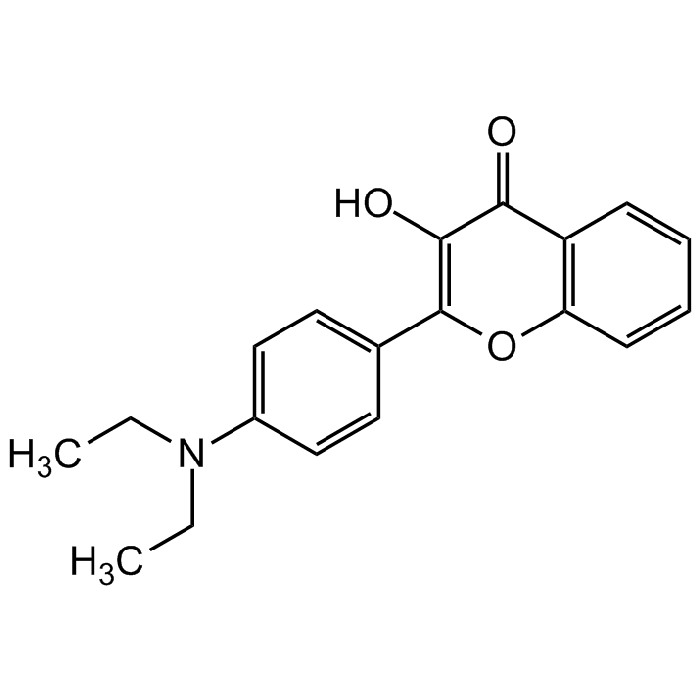Cookie Policy: This site uses cookies to improve your experience. You can find out more about our use of cookies in our Privacy Policy. By continuing to browse this site you agree to our use of cookies.
Chemodex
4'-Diethylamino-3-hydroxyflavone

| Product Details | |
|---|---|
| Synonyms | DEAHF; FE; DHF; DMHF |
| Product Type | Chemical |
| Properties | |
| Formula |
C19H19NO3 |
| MW | 309.36 |
| CAS | 146680-78-6 |
| Source/Host Chemicals | Synthetic. |
| Purity Chemicals | ≥90% (NMR) |
| Appearance | Yellow powder. |
| Solubility | Soluble in DMSO, ethanol, methanol or acetonitrile. |
| Identity | Determined by 1H-NMR. |
| Declaration | Manufactured by Chemodex. |
| Other Product Data |
Click here for Original Manufacturer Product Datasheet |
| InChi Key | NTRKEYLXTPNPIY-UHFFFAOYSA-N |
| Smiles | O=C1C2=C(C=CC=C2)OC(C3=CC=C(N(CC)CC)C=C3)=C1O |
| Shipping and Handling | |
| Shipping | AMBIENT |
| Short Term Storage | +4°C |
| Long Term Storage | -20°C |
| Handling Advice | Protect from light and moisture. |
| Use/Stability | Stable for at least 2 years after receipt when stored at -20°C. |
| Documents | |
| Product Specification Sheet | |
| Datasheet |
 Download PDF Download PDF |
Fluorescent dye that exhibits dual band fluorescence emission which is sensitive to environmental factors. One band originates from the normal excited state (N*) and the other is due to the excited state intramolecular proton transfer (ESPIT) reaction product tautomer (T*). An increase in solvent polarity and hydrogen bonding ability of the solvent leads to an increase in the population of the N* form relative to the T* form. The intensity ratio of the normal and tautomeric fluorescence bands are near 510nm and 570nm, with a main absorption band (370-420nm). There exists a latent third emission band peaked at 535nm, which is reliably recorded upon excitation at wavelengths of 470-500nm. The positions of the two bands, as well as their intensity ratios are sensitive to the local environment, making many of these compounds attractive ratiometric fluorescent sensors. Attaching such fluorophores covalently to peptides and proteins, peptide-membrane interactions and structural changes of proteins can be studied. Furthermore, this dye may have important future applications as fluorescent sensors for the detection of adenosine triphosphate (ATP), as their excitation spectra are sensitive to ATP and this effect is selective over other nucleotides.
(1) A. Sytnik, et al.; PNAS 91, 11968 (1994) | (2) Y.-M. Cheng, et al.; J. Phys. Chem. A 109, 11696 (2005) | (3) V.G. Pivorenko, et al.; J. Fluoresc. 16, 9 (2006) | (4) V.I. Tomin & R. Jaworski; Opt. Spectrosc. 109, 279 (2010) | (5) Y. Kimura, et al.; J. Phys. Chem. B 114, 11847 (2010) | (6) K. Hino, et al.; Bull. Chem. Soc. Jpn. 86, 721 (2013) | (7) D. Gosh, et al.; J. Phys. Chem. B 119, 5650 (2015) | (8) Z. Szakacs, et al.; Photochem. Photobiol. Sci. 15, 219 (2016) | (9) K. Furukawa, et al.; Chem. Phys. Lett. 643, 109 (2016)






